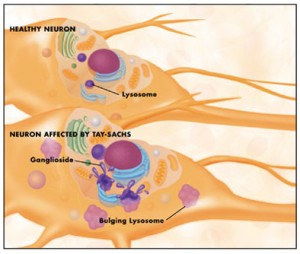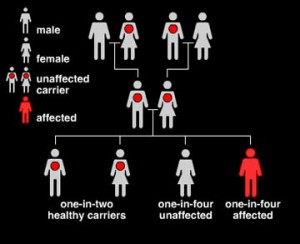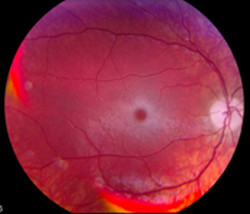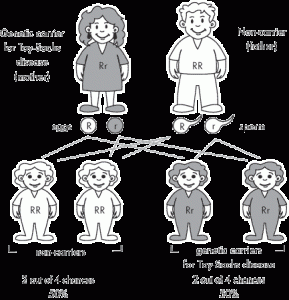Tay-Sachs disease - PubMed Health
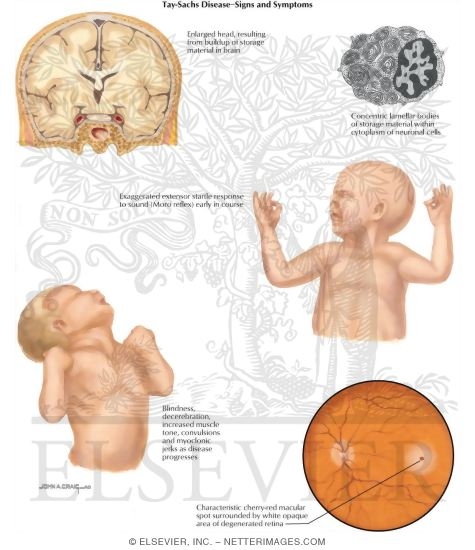
What is Tay Sachs Disease?
Tay Sachs Disease (TSD) is a rare disorder that affects the nerves of the brain. The condition is also known as Hexosaminidase A deficiency or GM2 Gangliosidosis.
The disease appears in three forms. These are :
Classic Infantile Tay Sachs Disease
This is the most common type of Tay Sachs Disease. The symptoms of this form of TSD are typically seen in children who are more than 6 months old. In worse cases, a child affected by this disorder may turn blind.
Juvenile Tay Sachs Disease
This condition is caused by a deficiency of the Hexosaminidase-A (Hex-A) enzyme. The symptoms of this form of Tay Sachs Disease appear in children between 2 and 5 years of age.
Chronic Tay Sachs Disease
This is also known as Late Onset Tay Sachs Disease. It is a rare form of TSD and is caused by a total lack of the enzyme Hexosaminidase-A (Hex-A). It develops in children who are slightly older in age.
History of Tay Sachs Diseas
Tay Sachs Disease is named after Warren Tay, a British ophthalmologist who was the first to report the symptom of the condition in 1881. He reported about a patient with a cherry red spot in the eye, which is one of the major signs of having this disease. It also owes a part of its name to a New York neurologist Bernard Sachs who reported about its incidence in babies of Eastern European Jewish origin.
Tay Sachs Disease Incidence
The condition arises in people of all ethnic backgrounds. However, it is more common in people of Askhenazi Jewish and Eastern European origin. Other high-risk communities are French Canadians, Pennsylvania Dutches and Louisiana Cajuns.
Tay Sachs Disease Symptoms
The signs of the disease are not generally apparent in the initial stages. A child born with this disease appears perfectly normal. It is only after sometime that the Tay Sachs Disease effects show themselves.
In the Classic Infantile form of the condition, the symptoms of Tay Sachs Disease start to appear when the child is 3-6 months old. The baby makes less movement. Smiling, eye contact and actions are reduced. The social skills are delayed. The baby’s ability to perceive and respond to its surroundings also suffers. The child lacks zest and becomes irritable. The head may grow larger than the rest of the body. The nerve cells expand due to fatty material.
In the advanced stages, the child may have difficulty in eating. The motor skills become impaired. The muscles are not well developed and the intelligence also gets affected.
In the final stages, the child may get blind or become deaf. Despite good care, most children with Tay Sachs Disease (TSD) die eventually.
Tay Sachs Disease Life Expectancy
The sufferers of this disease do not live too long. Many die before they are 4-6 years old while some can survive up to 12 or 13 years of age.
Tay Sachs Disease Causes
Tay Sachs Disease is generally caused by the deficiency or absence of the enzyme known as Hexosaminidase-A enzyme (Hex-A). An absence or low level of this enzyme causes an accumulation of a lipid or fatty substance called GM2 Ganglioside. This lipid deposits itself in the nerve cells. In patients of Tay Sachs Disease enzyme absence is the main causative factor.
The process of lipid accumulation is known as “Substrate”. It causes progressive damage of the nerve cells. This fatty material causes mental and physical deterioration in the sufferer.
For Tay Sachs Disease genetics plays a major role. Tay Sachs Disease results from a genetic mutation. A child can get this disease if both parents have this mutated gene. Generally, 1 in 250 people is a carrier of this disorder. But in some communities like Ashkenazi Jews, 1 in 27 people carry this chromosomal mutation. Children born out of a marriage within such a community are at high risk of developing this condition.
Tay Sachs Disease Diagnosis
The most common Tay Sachs Disease testing involves a blood test. A blood test can immediately determine this disorder.
Tay Sachs Disease cure is not possible. As of now, there is no cure for this health condition. Medicines are used only to keep the symptoms under control. In the initial stages, seizures are controlled with the aid of Anticonvulsant medicines.
Proper nutrition is required to keep the sufferer in good health. Hydration and similar methods are also necessary to keep the airways open.
In advanced stages, children may need a feeding tube. This will help kids suffering from problems in eating.
Therapies are also quite necessary in controlling the symptoms of this condition. Gene Therapy, Neural Cell Stem Therapy and Pharmacological Chaperone Therapy are some widely known therapies used to tackle the disorder.
Tay Sachs Disease Prevention
The prevention of this disease can be made possible through Tay Sachs Disease screening. Carrier Testing and Prenatal Testing are used to check the presence of any defective copy of a gene. These steps are used in couples who belong to high-risk populations such as Ashkenazi Jews. Ashkenazi Jews are found to be at high risk from this condition.
Tay Sachs Disease Pictures
Check out these pictures of Tay Sachs disease to understand more about it.
Tay Sachs Disease Prognosis
Tay Sachs Disease patients normally die by 4 years of age due to recurrent cases of infection. Despite best care, chances of survival are very dim. In a few cases, patients are seen to live only till 12 or 13 years of age. You cannot find Tay Sachs Disease in adults. People with Tay Sachs Disease do not survive till adulthood.
If you are a member of a community susceptible to this condition like Ashkenazi Jews, it is advisable that you seek medical help before starting a family. Prevention, as they say, is better than cure. And it is nowhere more applicable than an incurable disease like Tay Sachs Disease....
PRIMEHEALTH CHANNEL...
news about tay sachs disease at malaysia(malay version's)

PRIMEHEALTH CHANNEL...
More Common Questions
news about tay sachs disease at malaysia(malay version's)
Khalid pertama hidap Tay-Sachs
 |
KHALID banyak menghabiskan masanya di atas katil.
|
HATI ibu bapa mana yang tidak rawan apabila permata hati yang masih belum mengenal dunia disahkan menghidap penyakit yang mengganggu fungsi otak sekali gus menjadikan si comel terlantar.
Lebih menyedihkan, pakar perubatan yang ditemui pula memberitahu penyakit yang jarang-jarang ditemui itu masih belum ada penawarnya.
Tidak semua orang mampu berdepan dengan dugaan sehebat ini. Bagi pasangan Mohammad Imran Idris, 37, dan Asriyanti Mahattar@Mokhtar, 33, mereka reda dengan ketentuan Allah namun itu tidak bermakna mereka pasrah dan berhenti berusaha.
Menceritakan tentang anaknya, Mohammad Khalid, 3, doktor mengesahkan anak sulung daripada dua beradik itu menghidap Tay-Sachs. Sindrom Tay-Sachs merupakan penyakit genetik yang berlaku apabila terdapat lebihan kuantiti gangliosida iaitu sejenis terbitan asid lemak yang terkumpul dalam sel saraf otak.
Penyakit ini juga mempunyai kaitan dengan masalah kecelaruan enzim sehingga menyebabkan otak tidak berupaya memecahkan asid lemak tertentu.
Apabila keadaan berterusan, ia akan menghalang pemindahan maklumat oleh saraf dan menyebabkan kerosakan sel otak.
Dalam kajian perubatan terdahulu juga mendapati, individu yang menghidap penyakit ini mempunyai jangka hayat yang pendek iaitu di antara tiga hingga lima tahun.
"Khalid lahir sebagai anak yang normal. Malah dia boleh meniarap pada usia enam bulan, sama seperti bayi lain.
"Namun, selepas umurnya setahun, Khalid belum mampu duduk sendiri. Masa itu, saya tidak terfikir ia adalah satu penyakit. Saya hanya beranggapan mungkin perkembangan fizikal anak saya tidak secepat bayi-bayi lain," cerita Imran.
Ganjil
Enggan berdiam diri, Khalid dibawa berjumpa pakar kanak-kanak di beberapa hospital.
Hasil ujian pertama mendapati Khalid mempunyai keganjilan pada otaknya.
Asriyanti menambah, selepas Khalid berusia sembilan bulan, dia mendapat demam panas dan pada masa itu lebih banyak pemeriksaan dilakukan.
"Bermacam-macam ujian dilakukan terutamanya pada otak Khalid," katanya.
Tidak mahu bergantung pada satu pendapat sahaja, anak kecil ini turut dibawa ke hospital-hospital lain dan beberapa pemeriksaan dijalankan ke atasnya.
Ketika itu, doktor dapat mengesan ada titik merah ceri pada kedua-dua belah mata Khalid.
"Melihat pada kurang upaya Khalid untuk melakukan pergerakan otot-otot dan menegakkan badan, kami ingatkan Khalid mendapat masalah celebral palsy, tetapi sebenarnya tidak.
"Selepas sampel darah saya dan isteri diambil dan diuji di Australia, Khalid disahkan menghidap Tay-Sachs.
"Masa itu, jangankan kami, doktor yang merawat Khalid sendiri juga masih baru dengan Tay-Sachs, malah penerangan yang diberikan kepada kami merujuk kepada buku perubatan yang dibuka di depan matanya," kata Imran.
Menurut Asriyanti, pertengahan Ramadan lalu, Khalid tersedak susu dan ketika itu tubuhnya sudah membiru.
"Hanya Allah yang tahu macam mana perasaan saya ketika itu, namun saya cuba untuk bertenang.
"Selepas belakang badannya ditepuk-tepuk, baru Khalid nampak okey. Kami terus bawa dia ke hospital dan di sana dia ditahan lebih kurang 10 hari untuk dipantau memandangkan ketika itu sudah ada jangkitan pada paru-parunya," katanya.
Sel stem

SELEPAS insiden tersedak susu bulan lalu, Khalid kini diberi minum susu melalui tiub.
Walaupun tinggal lama di hospital, Asriyanti dan Imran dapat merasakan Khalid tidak berasa selesa di sana.
"Di hospital dia tidak boleh batuk sendiri dan tahap oksigen dalam badannya tidak konsisten, tetapi kalau di rumah, dia tiada masalah sebegitu," katanya.
Sebagai bapa, Imran sentiasa mahu berikan yang terbaik untuk Khalid.
Baik dari segi rawatan mahupun kemudahan, dia tidak sayang berbelanja asalkan anaknya itu selesa.
Cuma satu perkara yang merungsingkannya iaitu cara untuk mengubati Khalid.
"Saya sering melihat doktor seperti sudah terikat dengan fakta bahawa penawar Tay-Sachs belum ditemui.
"Saya pernah melihat rakaman video mengenai seorang kanak-kanak di Peru yang mengidap Tay-Sachs diberi suntikan sel stem terus pada otaknya.
"Usaha itu menunjukkan hasil positif apabila kanak-kanak itu sudah mampu mengangkat kepalanya.
"Saya ada juga mengutarakan perkara ini kepada pakar genetik yang mengambil kes Khalid namun beliau tidak mengesyorkan saya membuat rawatan sel stem kerana risikonya yang tidak boleh dijangka.
"Buat masa ini saya hanya mampu menunggu. Kalau ada pakar perubatan yang boleh memberi panduan kepada saya bagaimana saya harus merawat Khalid, saya amat menghargainya," jelas Imran.
~kosmo..~

